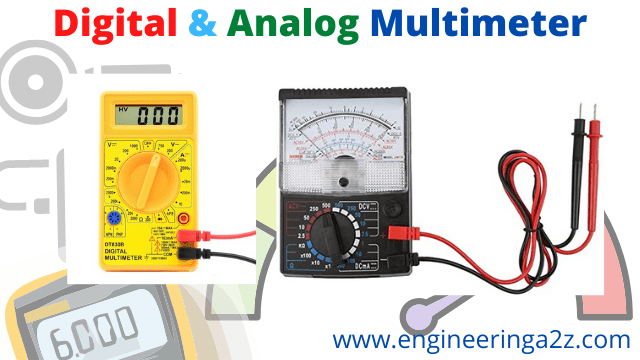
Table of Contents
Multimeter
A multimeter is a device that measures current, voltage, and resistance by combining the functions of an ammeter, voltmeter, and ohmmeter. It’s also known as AVO (Ampere-Volt-Ohm meter).
A fundamental d’Arsonval movement is used in the ammeter, voltmeter, and ohmmeter. The circuit in which the basic movement is used differs between various instruments. As a result, it is self-evident that an instrument can be developed to accomplish these three measurements. A “Multimeter” or “Volt-ohm-ammeter” is an instrument with a function switch that connects the proper circuits to the d’Arsonval movement.
Multimeter Diagram

Types of Multimeter
There are two types of multimeter:
- Analog multimeter
- Digital multimeter
1. Analog multimeter
They have a meter movement mechanism, a calibrated scale and a pointer. Reading is obtained by looking at the position of the pointer on the scale.

An Analog multimeter is a PMMC meter. It works on the principle of the D’Arsonval galvanometer. It has a needle that indicates the scale’s measured value. When current travels through a coil, it creates a magnetic field. The coil is secured by the indicating needle. A deflecting torque is produced by current flowing through the coil, causing the coil to rotate at an angle and the pointer to travel across a graduated scale.
2. Digital multimeter
In a digital multimeter, the meter movement is replaced by a digital readout. This is shown in figure as below.

This readout is similar to that used in electronic calculators. The internal circuitry of the digital multimeter is made up of digital integrated circuits. Like the analogue-type multimeter, the digital multimeter has a front panel switching arrangement. The quantity measured is displayed in the form of a four digit number, with a properly placed decimal point. When DC quantities are measured, the polarity is identified by means of a positive (+) or negative (-) sign displayed to the left of the number.
Fluke Digital Multimeters (DMMs) are found on more tool belts than any other equivalent test equipment, and they identify more issues. Each design is put to the test in every way imaginable: drops, shocks, humidity, and so on. Every Fluke Digital Multimeter comes with everything you need: precise measurements, consistent, dependable performance, a focus on safety, and the industry’s best guarantee.
Working of Multimeter
Multimeter can be used to measure voltage, current, and resistance, among other things. It is critical to understand how to check the circuit’s stability before measuring various parameters. Because of the circuit’s stability, you can detect flaws and troubleshoot the circuit. This allows for a very little amount of current to be supplied without resistance Rest of the instruments, instead of socket pins, we used function switch or range switch. With the help of function switch or range switch, we can set the ranges of AC and DC both and select the desirable value.
Precaution While Using Multimeter
- When working with a live circuit, never utilise the Ohm-meter section.
- Avoid connecting the ammeter portion to a voltage source in parallel.
- Keep your hands away from the test probes’ exposed metal clips and tips.
- Before working with the metre test leads, make sure they aren’t trayed or damaged.
- While measuring dc voltage make sure you have selected to dc portion otherwise our meter will be damaged.
- Check the polarity of terminal while measuring resistance
Multimeter Uses
This meter combines a multirange DC voltmeter, an AC voltmeter, a DC milliammeter, an ohm-meter, and an output meter into one device. The PMMC instrument uses a current range of 0-250A. The following uses with different range are below:-
- Measurement of AC/DC voltage.
- Current measuring in both AC and DC.
- Measurement of resistance
- To inspect the diode.
- Capacitance is measured.
- Frequency measurement
- It is used to test batteries
- It is used for testing continuity process. etc





Comments (1)
I’m not that much of a online reader to be honest but your blogs
really nice, keep it up! I’ll go ahead and bookmark your website to
come back in the future. Many thanks